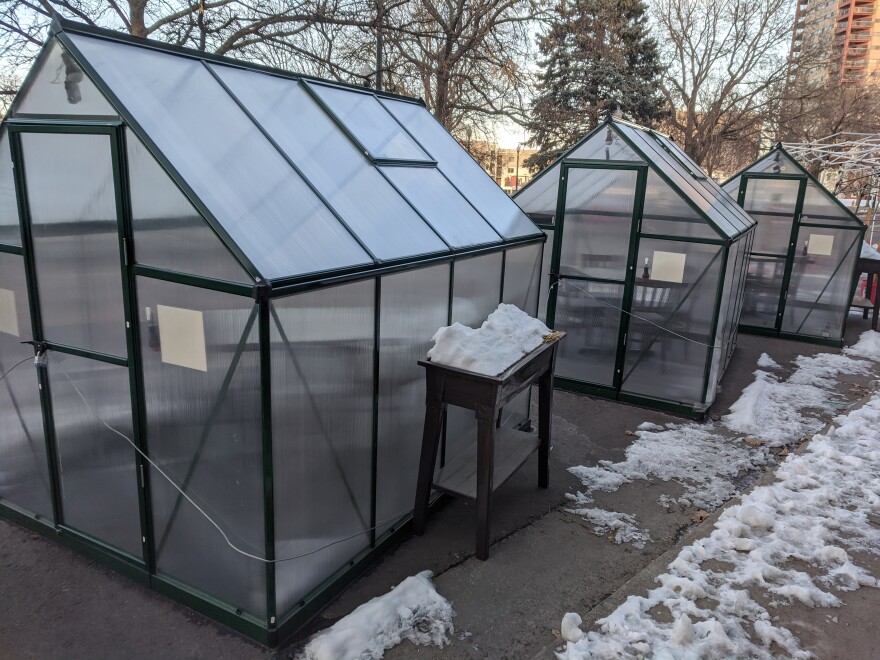Many restaurants on the Front Range are struggling to extend the outdoor dining season through the winter, as COVID-19 restrictions have shut down indoor dining completely in 33 counties.
During the warmer months, with indoor dining capacity restricted, but not eliminated, more than 50% of restaurant revenue came from outdoor patios, according to a recent survey by the Colorado Restaurant Association. That same survey showed a similar number of restaurant owners considered outdoor winter patios as essential to their short-term survival.
But not all outdoor patios are equally outdoors.
In September, the state released a set of guidelines for outdoor dining structures. Spaces for multiple parties that have a roof and at least two adjacent enclosed sides — such as large party tents — were considered indoors.
To be classified as outdoors, structures had to be unenclosed on opposite sides and open to continuous airflow. That open-ended configuration might be ideal for reducing the risk of COVID-19 transmission, but as Lauren Dundon, an architect with Semple Brown, pointed out, it also describes a wind-tunnel, and is likely at odds with customers’ physical comfort.
“Airflow brings fresh air, disperses the germs, and that's what we need,” Dundon said. “However, it also takes away all your heat that that you've built up in the air.”
In October, Dundon participated in a design event sponsored by the Colorado Restaurant Foundation that brought together architects, restauranteurs, contractors, public health officials and others to dream up a number of concepts for outdoor dining structures for the purposes of informing and inspiring the restaurant industry.
Dundon said her main takeaway from the effort was that restaurant patrons would have to let go of expectations for warmth when eating out this winter.
“We needed to affect the culture as much as the built environment,” she said of her team’s findings. “We needed to have — even in the cities — an apres-ski mentality that people would show up, bundled up. We can make something fun and inviting, but it's still cold.”
For restauranteurs who weren’t ready to embrace that open-air idea, the state guidelines did include one exception: fully enclosed spaces could count as outdoors as long as they were for single parties only and fully aired out in between uses.
That option sounded about right to Aileen Reilly. Trying to plan ahead for the coming winter, the Denver-based restaurant owner started researching outdoor dining options as soon as the state guidelines were announced. She looked at igloos and other tent-like contraptions, but ultimately landed on an off-the-shelf greenhouse structure.

In early October, Reilly bought a dozen of the small, 6-by-8-foot greenhouses — just large enough for a table of four — and spent a week assembling them in front of her two uptown Denver restaurants.
“We had a very diligent protocol,” Reilly explained, describing the careful operations she put in place when the greenhouses opened in late October. She set aside an hour and 45 minutes for each seating. “And then we went in there and aired it out completely for 30 minutes,” she said. “We sprayed every inch of it before another party would be allowed into the space.”
That cleaning regimen made it costly to operate the greenhouses, but they were popular with her restaurant patrons, and helped keep bookings up.
That lasted for about three weeks, until Level Red COVID-19 restrictions went into effect in Denver. Reilly was prepared for indoor dining to shut down. What she wasn’t prepared for was the 8 p.m. last call.
“As soon as I heard that eight o'clock curfew, my mind started spinning about what are we going to do?” Reilly said. “How are we going be able to seat these more than one time a night?”
Without drink sales after 8 p.m., the greenhouses would be operating at a loss.
Colorado Restaurant Association president and CEO Sonia Riggs says the industry has been hit particularly hard by the pandemic.
“Two things that restaurants need more than anything is cash and capacity,” she said. Both have been throttled by the COVID-19 restrictions. Riggs anticipates many more restaurant closures to come, especially among small, independently owned neighborhood joints.
The Restaurant Association created a grant to help defray the costs of winterizing outdoor dining spaces. More than 500 restauranteurs have applied for those grants and funds have already been distributed to nearly 130 applicants.
That includes Reilly, who received one of those grants in late November, helping her recoup some of the investment she made in those greenhouses. She is confident that her two establishments will survive the winter. But, once the stronger restrictions went into effect, she decided to end all in-person dining. The move forced her to furlough half of her remaining staff and she’s now down to about a quarter of her pre-pandemic workforce.
“I'm like longing and staring at them right now,” Reilly said of her greenhouses, which remain empty and locked along the streets in front of her restaurants. “I mean, it's tough to just see them sitting there and you're like, I could put people in here.”
For now, like a lot of other restaurants around town, Reilly is serving takeout only.







